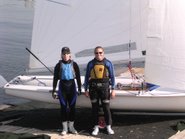We are driving around Chicago this morning. Construction detours make things confusing. We stayed with Clayton Root last night. He is a lake region native, grew up on scows and raced solings for a while. His most recent sailing pursuits are on a friend’s Farr 40. He is a Cornell alum and a real estate developer. Casey and I chatted with him last night about his Cornell sailing days before turning in for the night. It was a long drive yesterday; we hit 6 states over the 16 hour drive. All is well with the rig.
This morning we had breakfast at the Golden Apple diner near Clayton’s. Oh, we just found our way to I-55 again, so we are back on track. We go to Omaha today. Should be a much shorter day on the road. We are looking forward to the visit with the Hendrickson’s and Keith’s smoked BBQ ribs!
As Casey has the first shift driving today, it is time for me to reflect on our training experience in Newport. Since we began our blog only recently, we need to play catch up.
Our initial goal for Newport was to achieve mastery of the 470 in all conditions with regard to boat handling. We wanted to be able to pull off any maneuver in any wind strength and any sea state, and have general control of the boat at all times. In Niantic we had a couple of windy days, but relatively flat water. The first week we were sailing in Newport it happened to be pretty windy (15-22 knots). With the tall ships and regular seasonal boat traffic (ferries, yachts, cargo ships) we were intimidated. It was pretty clear to us that our boat handling had not progressed far enough for us to start taking big risks. So during this first week we stayed in the Bay and concentrated on tight boat handling drills in the higher breeze range. We were encouraged by Tracy Nan Smith, one of the greatest hardcore dinghy sailors in my network of friends, that pushing ourselves on the “triangle of death” would lead to great progress. It was a challenging time on the water.
We were working out tacking and gybing techniques using mainly guesswork, influenced a little bit by my memory. There don’t seem to be any available “from the experts” articles on 470 boat handling. Getting some coaching on the water seemed increasingly important. We didn’t want to learn the wrong ways of doing things, only to start all over again once we realized the error of our ways. We had a major stumbling block in our plans for guest coaches – no coach boat. You would not believe the number of hard bottom inflatables in Newport. They are everywhere. And they are being used all the time. Working out a charter seemed either way too expensive or way too inconvenient for the owners. I suppose we could have pushed a little harder, or hunted a little more creatively, but we were faced with time management issues. A huge reality of the US Olympic sailing campaign is that all of the management tasks parallel the athlete’s physical and skill training. During the day the athlete needs to do specific physical exercise to gain strength and endurance, practice on the water with a constructive plan for attaining goals and objectives, maintain the boat for functionality and safety, eat for health and energy, drink water, manage the sun, and get plenty of sleep. But the “campaign” also requires the athlete to fit in logistical work time as well: finances, networking, research… it is in this latter realm that finding a coach boat and scheduling guest coaches falls. The answer ended up being very simple, but when you are exhausted at the end of the day, the ideas and follow up don’t roll out of your head so easily. It wasn’t until the last 2 weeks of our Newport training that we managed to put something together. The Comfort family turned out to be a major ally to us. If we only had thought of this contact sooner! They loaned us their RIB so that Zack Leonard could come out on the water with us one Friday afternoon. Jeff Johnstone also loaned us his J Boats RIB so that Skip Whyte could coach us on two separate occasions. We also had a day on the water with Kiwi coach John Morgan, who borrowed a boat from Connanicut YC. These days with coaches on the water proved very valuable. Not only did the coaching lead to fruitful practice sessions packed full of learning for us, but each session ended up being a great confidence boost for us. Ironically, the few days we had with coaches confirmed that our solo work had been very productive, despite some of the frustration of navigating in-the-dark the intricacies of the 470. What this tells me is that the bottom line for us has been to spend as much time in the boat as possible. Casey and I are smart and driven people. No matter what we are doing in the boat, the time is productive. Our solo work has provided a platform for coaches to take off from when they work with us. We are more than a lump of clay. They see our potential.
My turn to drive. I’ll be back! -nb
Wednesday, August 8, 2007
Subscribe to:
Post Comments (Atom)

No comments:
Post a Comment